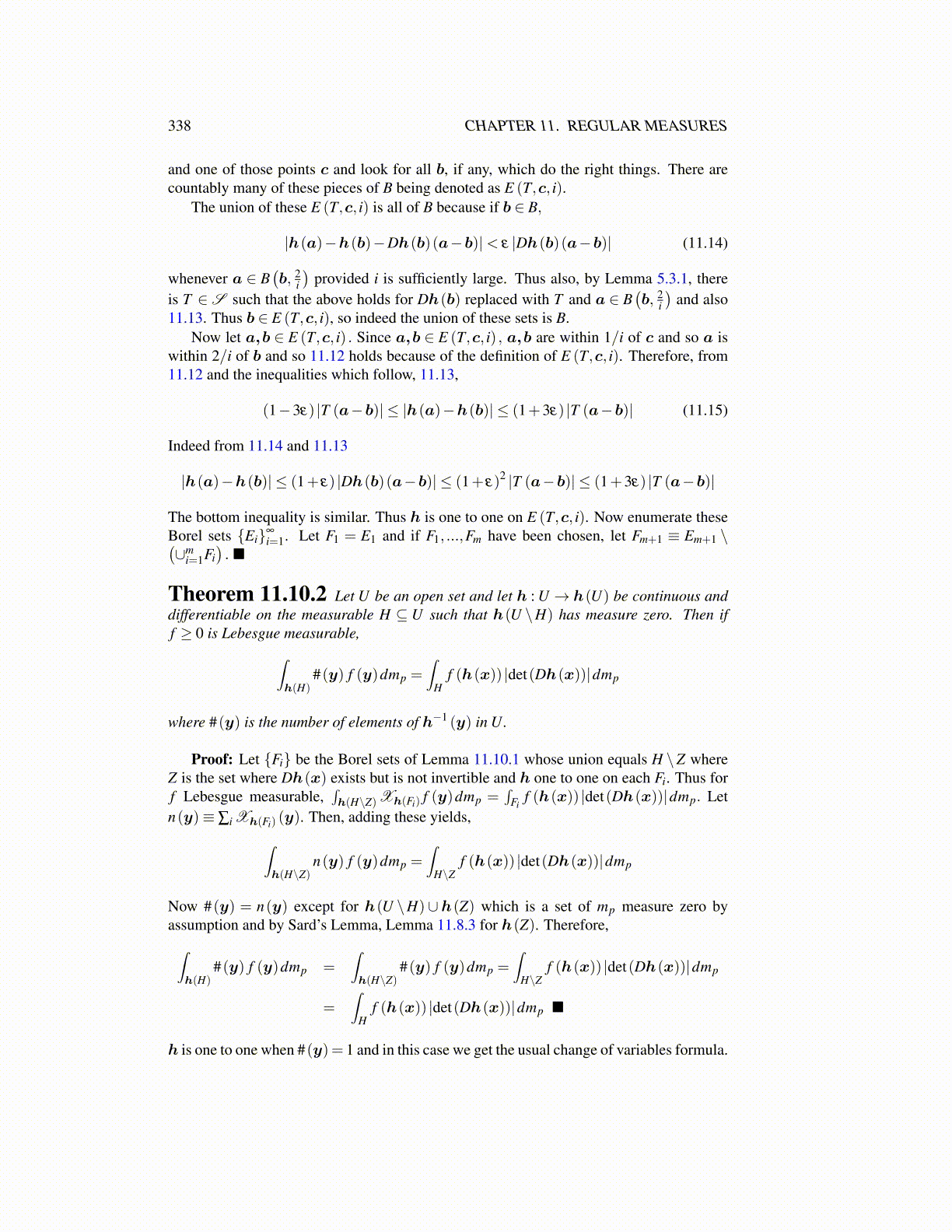
338 CHAPTER 11. REGULAR MEASURES
and one of those points c and look for all b, if any, which do the right things. There arecountably many of these pieces of B being denoted as E (T,c, i).
The union of these E (T,c, i) is all of B because if b ∈ B,
|h(a)−h(b)−Dh(b)(a−b)|< ε |Dh(b)(a−b)| (11.14)
whenever a ∈ B(b, 2
i
)provided i is sufficiently large. Thus also, by Lemma 5.3.1, there
is T ∈S such that the above holds for Dh(b) replaced with T and a ∈ B(b, 2
i
)and also
11.13. Thus b ∈ E (T,c, i), so indeed the union of these sets is B.Now let a,b ∈ E (T,c, i) . Since a,b ∈ E (T,c, i) , a,b are within 1/i of c and so a is
within 2/i of b and so 11.12 holds because of the definition of E (T,c, i). Therefore, from11.12 and the inequalities which follow, 11.13,
(1−3ε) |T (a−b)| ≤ |h(a)−h(b)| ≤ (1+3ε) |T (a−b)| (11.15)
Indeed from 11.14 and 11.13
|h(a)−h(b)| ≤ (1+ ε) |Dh(b)(a−b)| ≤ (1+ ε)2 |T (a−b)| ≤ (1+3ε) |T (a−b)|
The bottom inequality is similar. Thus h is one to one on E (T,c, i). Now enumerate theseBorel sets {Ei}∞
i=1. Let F1 = E1 and if F1, ...,Fm have been chosen, let Fm+1 ≡ Em+1 \(∪m
i=1Fi). ■
Theorem 11.10.2 Let U be an open set and let h : U → h(U) be continuous anddifferentiable on the measurable H ⊆ U such that h(U \H) has measure zero. Then iff ≥ 0 is Lebesgue measurable,∫
h(H)#(y) f (y)dmp =
∫H
f (h(x)) |det(Dh(x))|dmp
where #(y) is the number of elements of h−1 (y) in U.
Proof: Let {Fi} be the Borel sets of Lemma 11.10.1 whose union equals H \Z whereZ is the set where Dh(x) exists but is not invertible and h one to one on each Fi. Thus forf Lebesgue measurable,
∫h(H\Z)Xh(Fi) f (y)dmp =
∫Fi
f (h(x)) |det(Dh(x))|dmp. Letn(y)≡ ∑i Xh(Fi) (y). Then, adding these yields,∫
h(H\Z)n(y) f (y)dmp =
∫H\Z
f (h(x)) |det(Dh(x))|dmp
Now #(y) = n(y) except for h(U \H)∪h(Z) which is a set of mp measure zero byassumption and by Sard’s Lemma, Lemma 11.8.3 for h(Z). Therefore,∫
h(H)#(y) f (y)dmp =
∫h(H\Z)
#(y) f (y)dmp =∫
H\Zf (h(x)) |det(Dh(x))|dmp
=∫
Hf (h(x)) |det(Dh(x))|dmp ■
h is one to one when #(y)= 1 and in this case we get the usual change of variables formula.